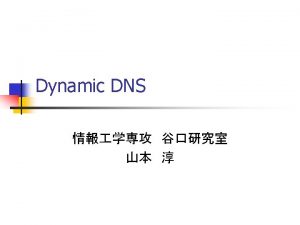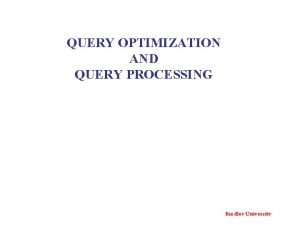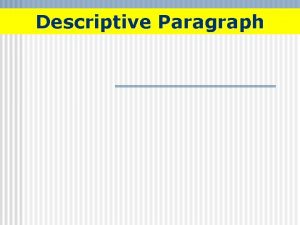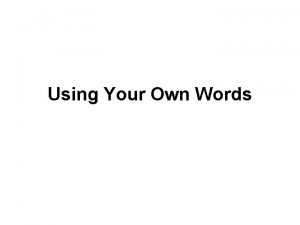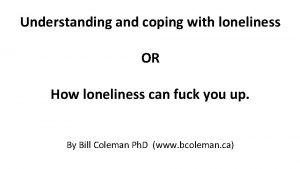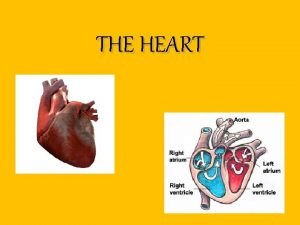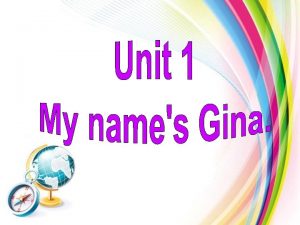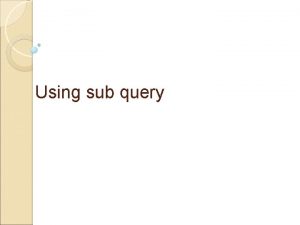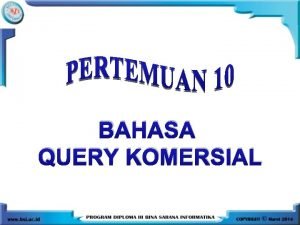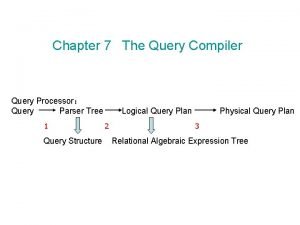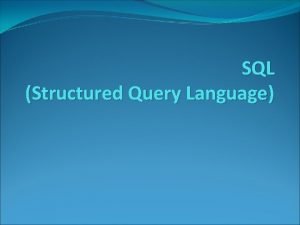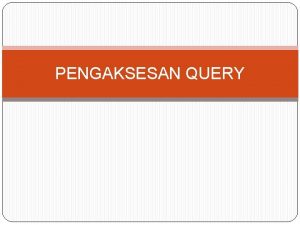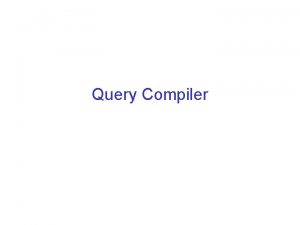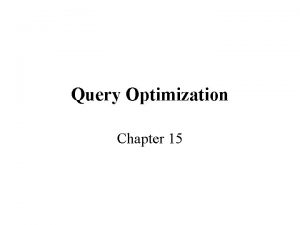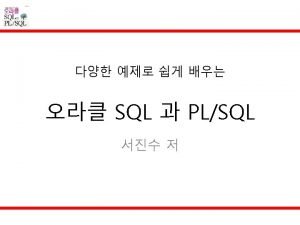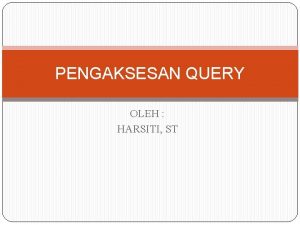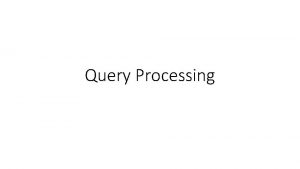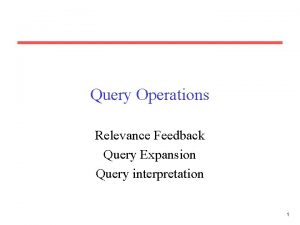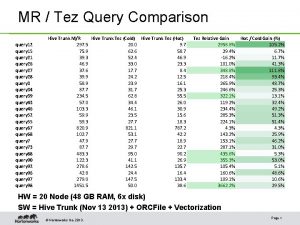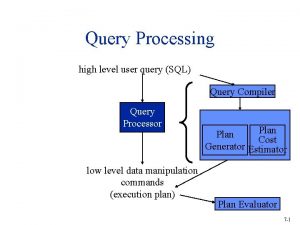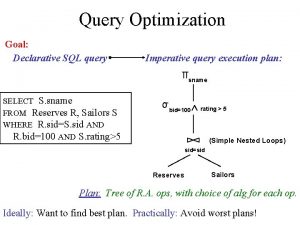j Query Awesomeness Using j Query In Your








![j. Query Boot Camp �j. Query Visual Effects & Transitions • Show/Hide �show([speed], [callback]), j. Query Boot Camp �j. Query Visual Effects & Transitions • Show/Hide �show([speed], [callback]),](https://slidetodoc.com/presentation_image/f678011de0a72453071d1b322c070f95/image-9.jpg)











- Slides: 20

j. Query Awesomeness Using j. Query In Your Arena Modules Jason Offutt Software Engineer Central Christian Church Email: jason. offutt@cccev. com Twitter: @yell 0 wdart Tweet about us using #Refresh. Cache!

j. Query Boot Camp �Drilling through the DOM with Selectors • j. Query Selectors are compatible with the CSS 3. 0 specification General: $(“input”); * Returns an array of ALL <input /> elements on the page Narrow: $(“div#main. Content input. form. Item: text); * Selects all <input type=“text” class=“form. Item” /> inside of the <div id=“main. Content”> element Specific: $(“#my. Text. Box: text”); * Selects only <input type=“text” id=“my. Text. Box” />

j. Query Boot Camp �this • The “this” keyword retains proper scope within j. Query �Using $(this) within an event handler will select the DOM element currently being interacted with �Traversing the DOM • j. Query’s API offers various helper methods for traversal �Positional methods: �first([selector]), last([selector]), next([selector]), prev([selector]) �$(this). next() – selects the next sibling relative to the current element �Relational methods: �parent([selector]), parents([selector]), siblings([selector]), children([selector]) �$(this). parent() – selects the immediate parent of the current element

j. Query Boot Camp �DOM Manipulation • CSS �css(“name”, “value”), css({ “name” : “value”}) – manipulates element’s “style” attribute �add. Class(“class”) – adds CSS class to the element’s “class” attribute �remove. Class(), remove. Class(“class”) – removes all CSS classes, or just the specified one from the element’s “class” attribute • Attributes �attr(“name”), attr(“name”, “value”) – returns the string value of the given attribute name, or sets the value of the given attribute name on the selected element �remove. Attr(“name”) – removes the given attribute from the selected element • Values, Text, HTML �val(), val(“value”) – returns the value of the selected input element or sets its value to the given string �text(), text(“value”) – returns the text value (no markup) of the selected element, or sets the inner text to the given string �html(), html(“value”) – returns an HTML string of the selected element’s inner HTML, or sets the inner HTML to the given string

j. Query Boot Camp �Branching • j. Query in common Java. Script branching structures �Using is([selector]) in an if block: �if ($(“#my. Textbox”). is(“: hidden”)) { } �Using val() in a switch block: �switch ($(“#my. Hidden. Field”). val()) { } �Looping • j. Query makes iteration easy with a “foreach” �Using each() to loop through an array: �$(“input: text”). each(function() { /* code inside the loop goes here */ }); �Use $(this) within the loop to reference the current array member

j. Query Boot Camp �j. Query Simple Events • Document Ready � THE j. Query event… Everything else happens inside it � Fired when the page has been loaded � $(document). ready(function() { }); • Most encompass traditional Java. Script events � click([event]) � focus([event]) � blur([event]) � mouseover([event]) � mouseout([event]) $(document). ready(function() { $(“#my. Delete. Button”). click(function(event) { if (some. Condition. Is. True) { return true; } }); event. prevent. Default(); return false; });

j. Query Boot Camp �j. Query Compound Events � Provide added functionality, more robust features � mouseenter(function([args]) { }) � mouseleave(function([args]) { }) � hover(function([args]) { }, function([args] { }) $(“div. panel”). hover( function() { // mouse enter // mouseenter code goes here }, function() { // mouse leave // mouseleave code goes here }); �mouseover/mouseout vs mouseenter/mouseleave � Traditional Java. Script mouseover and mouseout events (and their j. Query counterparts) are fired when the mouse enters or leaves the parent element OR any of its children. � Can cause unexpected results. May fire more than necessary. � j. Query’s mouseenter and mouseleave events are fired independently. A parent’s mouseenter event is completely independent of any child elements that have a mouseenter event bound to them.

j. Query Boot Camp �j. Query Live Events • Live Events �live(“event”, function(){ }), die(“event” function(){ }) �Used for binding and unbinding events to dynamically created DOM elements $(“input. form. Item: button”). live(“click”, function() { // event handling code goes here }); $(“input. form. Item: button”). die(“click”, function() { // event disposal/cleanup code goes here });
![j Query Boot Camp j Query Visual Effects Transitions ShowHide showspeed callback j. Query Boot Camp �j. Query Visual Effects & Transitions • Show/Hide �show([speed], [callback]),](https://slidetodoc.com/presentation_image/f678011de0a72453071d1b322c070f95/image-9.jpg)
j. Query Boot Camp �j. Query Visual Effects & Transitions • Show/Hide �show([speed], [callback]), hide([speed], [callback]) – Show or hide a DOM element by adjusting it’s visibility and display settings • Fading �fade. In([speed], [callback]), fade. Out([speed], [callback]) – Smoothly fades in or fades out a DOM element by adjusting it’s opacity • Sliding �slide. Up([speed], [callback]), slide. Down([speed], [callback]), slide. Toggle() – Smoothly slides a DOM element up or down by adjusting it’s offset height

j. Query Boot Camp �Resources • • j. Query Documentation j. Query API Browser j. Query Plugins j. Query. UI

j. Query Deep Dive �Selecting ASP. NET controls with j. Query • Easily done inline with ASP. NET’s data binding tags $(“#<%= my. Button. Client. ID %>”)… While very easy, this technique is ONLY available to Java. Script code written inline in your aspx or ascx page. We can’t utilize a separate code file. This leads to one major problem…

j. Query Deep Dive Inline Java. Script is for n 00 bs… Real developers use separate code files! How do we solve such a dilemma?

j. Query Deep Dive How can we select an ASP. NET control based on its client ID? Advanced j. Query Selector Kung-Fu � Partial attribute value selectors • Attribute Equality “=“ � $(“input[id=‘my. Text. Box’]”)… • Attribute Inequality “!=“ �$(“input[id!=‘my. Text. Box’]”)… �This will select <inputs /> without an id attribute AND <inputs /> with an id attribute that is NOT EQUAL TO “my. Text. Box” • Attribute Starts With “^=“ �$(“input[id^=‘my. Text. Box’]”)… • Attribute Ends With “$=“ �$(“input[id$=‘my. Text. Box’]”)… • Attribute Contains “*=“ �$(“input[id*=‘my. Text. Box’]”)…

j. Query Deep Dive j. Query and ASP. NET AJAX � � The $(document). ready() by itself works great… if you’re not dealing with a page that contains any Update Panels. When a partial postback occurs, all j. Query events bound to controls INSIDE an Update Panel get unbound. ¡Ay Dios mío! (OMG!)

j. Query Deep Dive Page. Request. Manager to the rescue! � � Singleton implementation, similar to the Script. Manager Utilizes a page life-cycle, similar to ASP. NET’s server-side page lifecycle • • • � Initialize Request Begin Request Page Loading Page Loaded End Request Event handling in traditional. NET style • Optional sender and args parameters for each page event $(document). ready(init. All); Sys. Web. Forms. Page. Request. Manager. get. Instance(). add_end. Request(init. All); function init. All() { // all j. Query events for your module are bound here }

j. Query Deep Dive Maintaining Client “State” Across Server Posts • Problem: �You have a collapsible panel with form controls that generate a server post. You want to keep the panel open after post, but since the web is stateless, your panel is always closed by default (as defined in your CSS) after a postback. • Solution: Abuse hidden fields to keep track of state information �Hidden fields participate in View State, so their value will persist across server posts Your markup might look like this: <input type=“hidden” id=“ih. Panel. Open” runat=“server” /> <div class=“panel”>HTML text, form stuff, etc</div> Your Java. Script could do this: var hidden. Field = $(“input[id$=‘ih. Panel. Open’]: hidden”); if (hidden. Field. val() == “true”) { hidden. Field. next(“div. panel”). show();

j. Query Deep Dive j. Query vs ASP. NET AJAX element selection • Both perform similar tasks �ASP. NET AJAX’s $get() & $find() �Both return a DOM element �$get() is shorthand for document. get. Element. By. Id() �$find() is shorthand for Microsoft’s Sys. Application. find. Component() �Both are static method calls

j. Query Deep Dive j. Query vs ASP. NET AJAX element selection • Both perform similar tasks �j. Query’s $() (or j. Query()) �$() returns an array of j. Query objects �j. Query objects wrap DOM element properties within framework method calls �“$” is shorthand for “j. Query” �$ is an object

j. Query Deep Dive �Using the Fire. Bug Console to troubleshoot your j. Query Selectors

j. Query Awesomeness �Any • • • Questions? Email: jason. offutt@cccev. com Twitter: @yell 0 wdart IRC: irc: //chat. freenode. net/Arena. Ch. MS GTalk: jason. offutt@gmail. com Web: http: //jordanrift. com
 Awesomeness
Awesomeness Iterative query
Iterative query Query tree and query graph
Query tree and query graph Query tree and query graph
Query tree and query graph Give us your hungry your tired your poor
Give us your hungry your tired your poor System.collections.generics
System.collections.generics Defrost using internal heat is accomplished using
Defrost using internal heat is accomplished using Acrostic poem
Acrostic poem Spatial writing examples
Spatial writing examples Imaginative story
Imaginative story Using your own words
Using your own words Comparative of tasty
Comparative of tasty Describe about mother
Describe about mother In your notebook answer the questions using used to
In your notebook answer the questions using used to Coping with gay loneliness
Coping with gay loneliness Stop blaming your parents for your problems
Stop blaming your parents for your problems What does the heart do
What does the heart do Funny poems for kids
Funny poems for kids How to introduce your friend to your teacher
How to introduce your friend to your teacher Wear your heart on your sleeve idiom meaning
Wear your heart on your sleeve idiom meaning In your notebook answer the questions
In your notebook answer the questions

